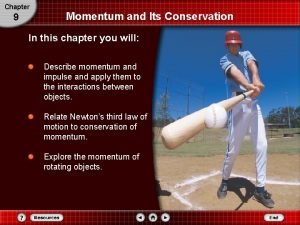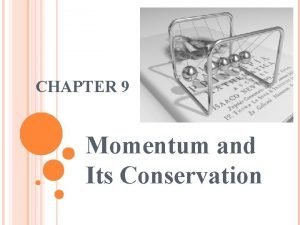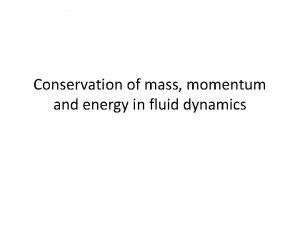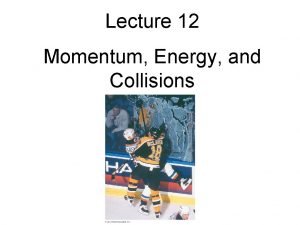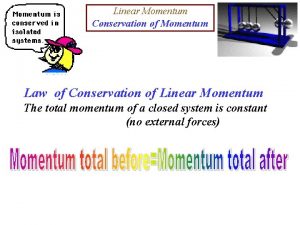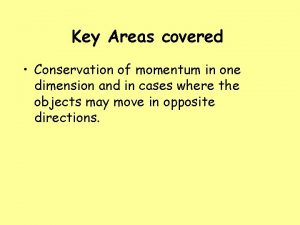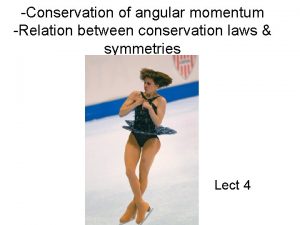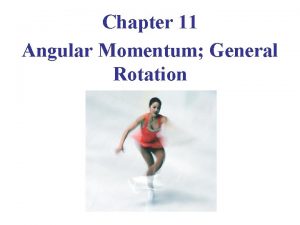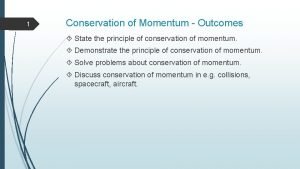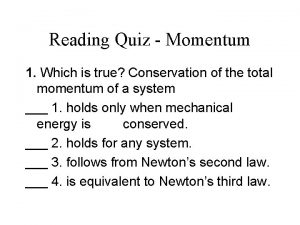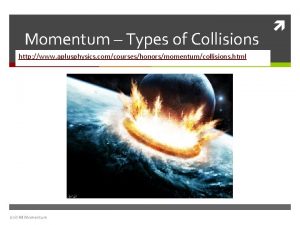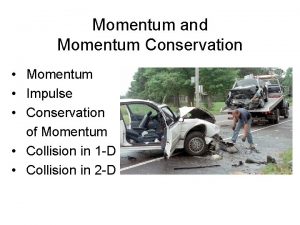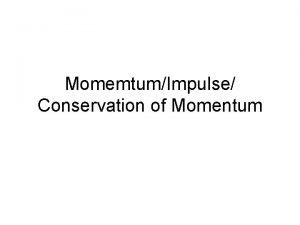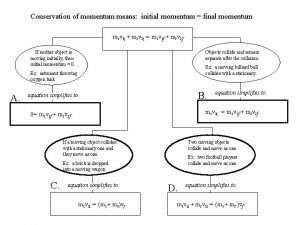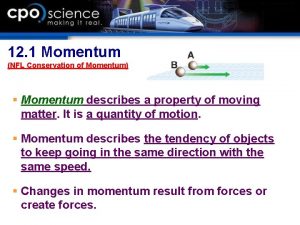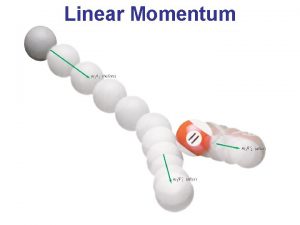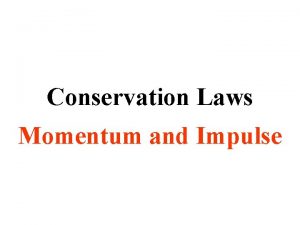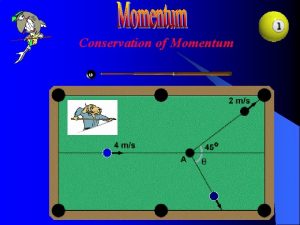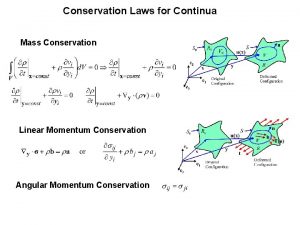Momentum and Its Conservation Ch 9 Conservation Laws



















- Slides: 19

Momentum and Its Conservation Ch. 9

Conservation Laws • In general, a law of conservation of any kind states that some property will be conserved, or remain constant, during an interaction.

9: 1 Impulse and Change in Momentum • If you have a large mass and a small mass moving at the same velocity, we know that a larger force must be used to stop the larger mass in the same amount of time. • If there are 2 equal masses where one is moving faster than the other, we know that the faster moving object requires a greater force to stop it. • Using these ideas of mass and velocity and applying them to force, we can change Newton’s second law of motion:

• Ft = mΔv or I=F(t) – The product of unbalanced force and the interval of time (t) that is exerted is called impulse. – Impulse unit = N*s (Newton*second) – Direction of impulse is in the direction of force. • Momentum is the product of an object’s mass and velocity and is represented by p. p = mv • A change in momentum is the product of the mass and the change in velocity, assuming mass is constant. Δp = mΔv • Notice anything about momentum and impulse?

• The change in momentum of a body is equal to the impulse given it. • So… Δp = Ft!

Example • A force of 20 N acts on a 2. 0 -kg mass for 10 s. Compute a. the impulse and b. the change in velocity of the mass.

Example 2 • A car that weighs 7840 N is accelerated from rest to a velocity of 25. 0 m/s eastward by a force of 1000 N. a. What was the car’s change in momentum? b. How long did the force act to change the car’s momentum?

Assignment • Pg. 150 #1, 2, 4, 5.

9: 2 Newton’s Third Law and Momentum • 3 rd Law is known as the law of action and reaction. – It’s equivalent to the conservation of momentum. – A single force cannot exist. Every force on a body is accompanied by an equal and opposite force on another body.

• The momentum gained by one body in an interaction is equal to the momentum lost by the other. Object A Object B Ft = -Ft mΔv = -mΔv Δp. A = -Δp. B

9: 3 - Law of Conservation • An isolated system is a system that has no net external force acting on it. – The law of conservation of momentum holds for any isolated system. • Law of Conservation of Momentum: The total momentum of an isolated system does not change. – Initial momentum of an isolated system = final momentum. – The momentum lost by one object in a collision is gained by the other. – Momentum is only transferred in a collision. Total momentum is constant. p. A + p. B = p’A + p’B Where p’ represents final momentum

Example: • A steel glider of mass 0. 50 kg moves along an air track with a velocity of 0. 75 m/s. It collides with a second steel glider of mass 1. 0 kg moving in the same direction at a speed of 0. 38 m/s. After the collision, the first glider continues with a velocity of 0. 35 m/s. What is the velocity of the second glider after the collision?

• Pg. 155 #8 -11 HW

9: 4 Internal and External Forces • An internal force can never change the momentum within a system. – An external force, originating outside the system, is needed to change the momentum of the system. • Depending on how you define the system, a force can be either internal or external. – Skater example

Example: • What is the recoil velocity of a 1. 20 x 103 kg launcher if it projects a 20. 0 kg mass at a velocity of 6. 00 x 102 m/s?

Practice! • HW: p. 157 #12 -15

9: 5 Conservation of Momentum in General • The law of conservation of momentum holds for all interactions, even those that occur in 2 or 3 dimensions. – Momentum is conserved regardless of the direction of the particles before and after they collide. – The total momentum is the vector sum of the momenta of all the pieces of a system.

Example: • A 2. 0 kg ball is moving at a velocity of 5. 0 m/s. It collides with a stationary ball also of mass 2. 0 kg. After the collision, the first ball moves off in a direction 30. 0 degrees to the left of its original direction. The second ball moves off in a direction 90. 0 degrees to the right of ball A’s final direction. A. Draw the vector diagram to find the momentum of the first ball and of the second ball after the collision. B. What is the speed of each ball after the collision?

Homework! • Pg. 160 #17 -19.
 Momentum and its conservation chapter 9
Momentum and its conservation chapter 9 Total momentum formula
Total momentum formula A 1875 kg car going 23 m/s
A 1875 kg car going 23 m/s When a train increases its velocity its momentum
When a train increases its velocity its momentum A 120 kg lineman moving west
A 120 kg lineman moving west Fluid
Fluid Conservation of mass momentum and energy equations
Conservation of mass momentum and energy equations Example of collision
Example of collision Conceptual physics momentum
Conceptual physics momentum Charles de secondat
Charles de secondat Law of conservation of momentum
Law of conservation of momentum Law of conservation of momentum
Law of conservation of momentum Law of conservation of linear momentum
Law of conservation of linear momentum Conservation of momentum
Conservation of momentum Law of conservation of angular momentum
Law of conservation of angular momentum Conservation of momentum definition
Conservation of momentum definition Law of conservation of angular momentum
Law of conservation of angular momentum State the principle of conservation of momentum
State the principle of conservation of momentum Conservation of momentum quiz
Conservation of momentum quiz Aplusphysics momentum-conservation answer key
Aplusphysics momentum-conservation answer key
